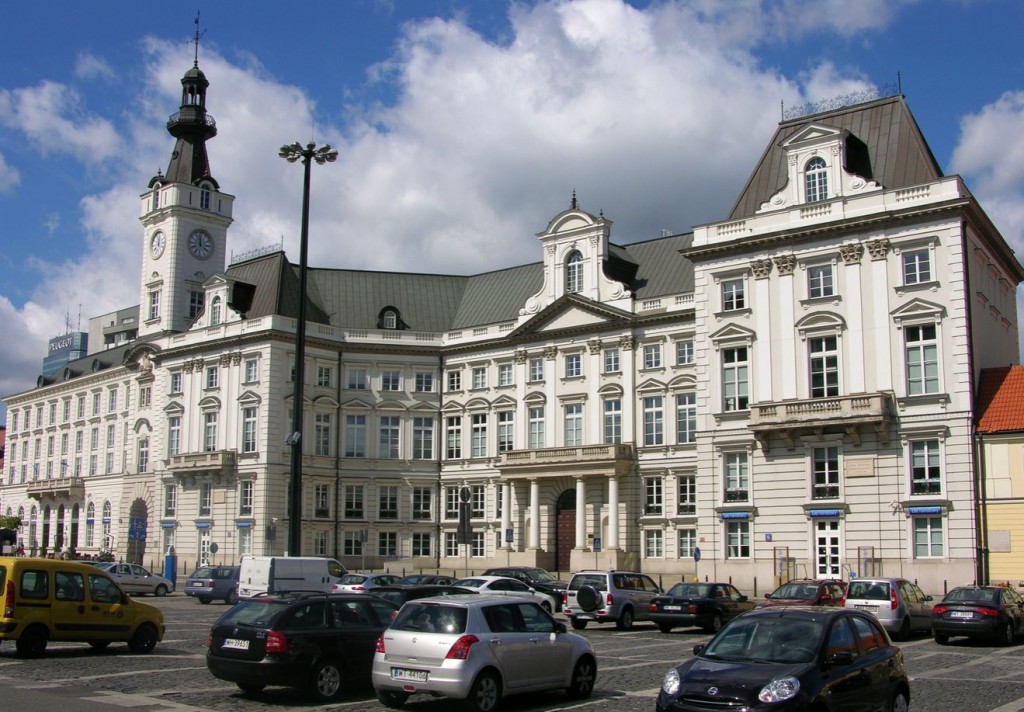Cześć!
W tym wpisie chciałbym Wam przedstawić Pałac, którego kopię możemy oglądać dziś na Placu Teatralnym.
Pałac Jabłonowskich, bo o nim mowa został zbudowany w latach 1773-1785 dla Antoniego Jabłonowskiego (stąd funkcjonująca do dziś nazwa) według projektu Jakuba Fontany i Domenico Merliniego, natomiast był w późniejszych okresach wielokrotnie przebudowywany, a mianowicie:
– w latach 1817-1819 na ratusz miejski, kiedy to przejął funkcję rozebranego starego ratusza na Rynku Starego Miasta;
– po powstaniu styczniowym (kiedy to było? Acha! 1863 rok ![]() ), kiedy to uległ pożarowi. Wtedy też między innymi dodano charakterystyczną wieżę strażacką z zegarami po jej 3 stronach, a w ramach kompleksu znalazła się m.in. siedziba II Oddziału Warszawskiej Straży Ogniowej;
), kiedy to uległ pożarowi. Wtedy też między innymi dodano charakterystyczną wieżę strażacką z zegarami po jej 3 stronach, a w ramach kompleksu znalazła się m.in. siedziba II Oddziału Warszawskiej Straży Ogniowej;
– w latach 1936-1939, kiedy to kolejna modernizacja pałacu objęła przebudowę dachu w 1936 oraz wzniesienie nowego, siedmiopiętrowego budynku od strony ul. Daniłłowiczowskiej.
We wrześniu 1939 roku w Pałacu w czasie obrony Warszawy cywilną obroną dowodził najsłynniejszy przedwojenny prezydent – Stefan Starzyński, dla ścisłości komisaryczny prezydent (nigdy nie był wybrany, ale to najmniej ważny fakt z jego życia).
Po wojnie w roku 1952 rozebrano wypalone ruiny Pałacu, a fundamenty przykryto nawierzchnią placu Teatralnego. Na miejscu pałacu w 1964 roku stanął pomnik Nike (kto go pamięta?)
Dopiero w latach 1995-1997 Pałac został zbudowany na siedzibę dwóch banków, co poprzedziły wykopaliska archeologiczne. Oczywiście pomnik Nike został przeniesiony – na wyższy cokół bliżej trasy WZ.
Współczesny budynek zrealizowano w formie żelbetowej, zachowując pierwotną bryłę (z odbudową wieży włącznie) i rekonstruując fasadę według stanu sprzed roku 1936.
Jak się przyjrzycie, to widać strop pięter w środku okien frontowych, jest to efekt połączenia budynku biurowego o dzisiejszych standardach z niejako „maską” fasady historycznego budynku. Zdania są mocno podzielone ale ostatecznie taka „wydmuszka”, jak niektórzy nazywają dzisiejszy Pałac jest wg mnie zdecydowanie lepsza aniżeli pustka na północno-zachodniej pierzei placu, bądź już kompletnie nie wpasowujący w okolicę szklany biurowiec. Sami osądźcie ![]() .
.
Pierwsze trzy zdjęcia to Pałac w oryginale, kolejne to jego brak i pomnik Nike (lata 60.) oraz ostatnie dwa – stan obecny.
Hey!
In this post I’d like to introduce you to the Palace, a copy of which can be seen today at the Theatre Square.
Jabłonowski Palace, questioned here was built between 1773-1785 for Antoni Jabłonowski (hence the name), designed by Jakub Fontana and Domenico Merlini, and was subsequently rebuilt several times, namely:
– In the years 1817-1819 as the town hall, when it took over the function from demolished old Town Hall on the Old Town Square;
– After the January Uprising against Russians (when was that? Oh! 1863 ;)), when it was burned down. Then among other things a firemen tower was added with clocks on its 3 sides, at that time it also became a seat of 2nd Warsaw Fire Department;
– In the years 1936-1939, when the next upgrade of the palace included the reconstruction of the roof in 1936, and the rise of a new, seven-story building from the Daniłłowiczowska street.
In September 1939 during the defense of Warsaw, at the Palace civil defense was commanded by the most famous pre-war president – Stefan Starzynski, for the record – the appointed president (he was never elected, but this is the least important fact of his life).
After the war in 1952 the burned ruins were demolished, and covered by the surface of the Square Theatre. On the site of the palace in 1964 the monument of Nike was erected by (who remember her?)
Only in the years 1995-1997, the Palace was built as the seat of the two banks, which was preceded by archaeological excavations. Of course, Nike monument was moved – to a higher pedestal closer to Al. Solidarności called WZ thoroughfare.
Contemporary building was realized in the form of reinforced concrete, while retaining its original shape (including the reconstruction of the tower) and reconstructing of the facade according to the state before 1936.
When taking closer look, you can see the ceiling of floors in the middle of the front windows, this is the result of the connection of the office building of modern standards with the kind of „mask” i.e. the facade of a historic building. Opinions are strongly divided but ultimately this „a shell”, as some call it today is in my opinion much better than the emptiness on the north-west side of the square, or other glass office building completely not fitting in the area. Judge for yourselves;).
The first three photos are of original palace, next – its lack and a monument of Nike (1960s), the last two – present day.

